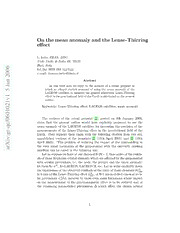
On the mean anomaly and the Lense-Thirring effect PDF
Preview On the mean anomaly and the Lense-Thirring effect
On the mean anomaly and the Lense-Thirring effect L. Iorio, FRAS, DDG Viale Unita` di Italia 68, 70125 Bari, Italy 6 0 tel./fax 0039 080 5443144 0 e-mail: [email protected] 2 n Abstract a J In this brief note we reply to the authors of a recent preprint in 5 which an alleged explicit proposal of using the mean anomaly of the LAGEOS satellites to measure the general relativistic Lense-Thirring 1 effectinthegravitationalfieldoftheEarthisattributedtothepresent v author. 1 2 Keywords: Lense-Thirring effect; LAGEOS satellites; mean anomaly 0 1 0 6 0 The authors of the recent preprint [1], posted on 4th January 2006, / claim that the present author would have explicitly proposed to use the c q mean anomaly of the LAGEOS satellites for increasing the precision of the - r measurements of the Lense-Thirring effect in the gravitational field of the g Earth. They support their claim with the following citation from two old, : v unpublished versions of the preprints [2] (19th April 2005) and [3] (19th i X April 2005): “The problem of reducing the impact of the mismodeling in r the even zonal harmonics of the geopotential with the currently existing a satellites can be coped in the following way. LetussupposewehaveatourdisposalN(N> 1)timeseriesoftheresidu- alsofthoseKeplerianorbitalelementswhichareaffectedbythegeopotential with secular precessions, i.e. the node, the perigee and the mean anomaly: A letthembeψ ,A=LAGEOS,LAGEOSII,etc. Letuswriteexplicitly down the expressions of the observed residuals of therates of those elements δψ˙A obs in terms of the Lense-Thirringeffect ψ˙A , of N-1 mismodelled classical secu- LT lar precessions ψ˙.AℓδJℓ induced by those even zonal harmonics whose impact on the measurement of the gravitomagnetic effect is to be reduced and of the remaining mismodelled phenomena ∆ which affect the chosen orbital 1 element δψ˙oAbs = ψ˙LATµLT+ X ψ˙.AℓδJℓ +∆A, A = LAGEOS, LAGEOS II,... N−1 terms | {Nz } (1) The parameter µLT is equal to 1 in the General Theory of Relativity and 0 in Newtonian mechanics. The coefficients ψ˙A are defined as .ℓ ψ˙.ℓ = ∂ψ˙class (2) ∂Jℓ andhavebeenexplicitlyworkedoutforthenodeandtheperigeeuptodegree ℓ = 20 in Iorio (2002b; 2003a); they depend on some physical parameters of the central mass (GM and the mean equatorial radius R) and on the satellite’s semimajor axis a, the eccentricity e and the inclination i. We can think about Eq. (1) as an algebraic nonhomogeneuous linear system of N equations in N unknowns which are µLT and the N-1 δJℓ: solving it withrespecttoµLT allows toobtain alinear combination oforbitalresiduals which is independent of the chosen N-1 even zonal harmonics.”. The authors of [1] seem to be not aware of [4], posted on 3rd August 2005, inwhichthisquestionwasalreadytackled andfullyexplained(Section 4, pag.7). Thus, we invite the interested readers and the authors of [1] to go through [4]. In it there are also detailed analyses (Section 2) of the unfeasible proposalby the authors of [1] of using the existing polar satellites to measure the Lense-Thirring effect and a quantitative discussion of the possibility of using the satellites Jason-1 and Ajisai (Section 3). Here we limit to note that the interpretation of the cited passage put forth by the authors of [1] is misleading and untenable. Indeed, in [2, 3], and other papers of him, the author of this note presented in the most gen- eral way thelinear combination approach simply enumerating theKeplerian orbital elements affected by the even zonal harmonics of the Earth’s geopo- tential with secular precessions, i.e. the node, the perigee and the mean anomaly. In no way that fact can be assumed as an explicit proposal of using the mean anomaly for testing the Lense-Thirring effect: for example, no explicit linear combinations including such an orbital element can be found in all the published (and unpublished) works by the present author. Moreover, in [2, 3] it is explicitly written just after the passage previously cited bytheauthorsof [1]:“Ingeneral, theorbitalelements employed arethe nodes and the perigees [...]” (Section 2.1.2, pag.8 of [2] and Section 2.1.1, pag.6 of [3]). The authors of [1] miss to cite such statement. 2 As already pointed out in [4] (Section 4, pag.7), one of the authors of [1] did explicitly use the mean anomaly of LAGEOS II in some tests conducted with the EGM96 model and published in papers and proceedings books. References [1] Ciufolini, I., and Pavlis, E.C., On the Measurement of the Lense- Thirring effect Using the Nodes of the LAGEOS Satellites in reply to ”On the reliability of the so-far performed tests for measuring the Lense-Thirring effect with the LAGEOS satellites” by L. Iorio, http://www.arxiv.org/abs/gr-qc/0601015, 2006. [2] Iorio, L., On the reliability of the so far performed tests for measuring the Lense-Thirring effect with the LAGEOS satellites, http://www.arxiv.org/abs/gr-qc/0411024v9, 2005a. [3] Iorio, L., Some comments on the recent results about the mea- surement of the Lense-Thirring effect in the gravitational field of the Earth with the LAGEOS and LAGEOS II satellites, http://www.arxiv.org/abs/gr-qc/0411084v5, 2005b. [4] Iorio,L.,Ontheimpossibilityofusingcertainexistingspacecraftfor themeasurementoftheLense-Thirringeffectintheterrestrialgrav- itationalfield,http://www.arxiv.org/abs/gr-qc/05080124v2,2005c. 3
